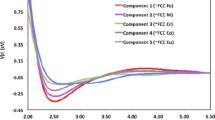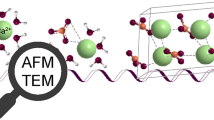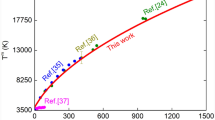Abstract
The system magnetite-Au-hydrothermal solution was employed to continue studying the distribution coefficients of trace elements in system with real crystals. The role of surface nonautonomous phase (NP) is elucidated. The distribution coefficient of an Au structural admixture between magnetite and hydrothermal solution at the experimental conditions [450°C, 1 kbar (100 MPa), and fluid sampling by a trap] is, according to the most representative data, 1.0 ± 0.3, and Au is thus not an incompatible element in magnetite, in contrast to pyrite and arsenopyrite [1], minerals for which this coefficient is much lower than one. The NP is enriched in Au with respect to the rest of the crystal by a factor of more than 4000, and this results in an one order of magnitude increase in the bulk distribution coefficient. Similar to pyrite, the reason for the dualistic nature of the distribution coefficient is the presence of an NP, which contains ∼2000 ± 500 ppm Au. The NP occupies the approximately 330-nm surface layer of the crystal, and the chemically bound Au [Au(III), according to XPS data] admixture is evenly distributed with depth within the layer, which is the reason for the strongly determinate dependences of the concentrations of the evenly distributed Au admixture on the size and specific surface area of the crystal. The occurrence of an NP is controlled by the chemistry of the system. The partial substitution of Fe for Mn and the synthesis of a phase close to jacobsite MnFe2O4 results in the disappearance of both the NP itself and the size dependence of the Au concentration. The XPS spectra of O 1s and Fe 2p are used to analyze two models: (i) a single goethite-like (O2−/OH−∼ 1) phase of variable composition and Fe in more than one valence state and (ii) a heterogeneous structure of alternating domains of wuestite- and goethite-like NP. The reason for the “excess” admixture in the former instance can be vacancies at Fe sites, whereas that in the latter one is the interaction of the admixture with nanometer-in-size nanometer in-size strained domains on the surface of the crystal.
Similar content being viewed by others
References
V. L. Tauson, D. N. Babkin, T. M. Pastushkova, T. S. Krasnoshchekova, E. E. Lustenberg, O. Yu. Belozerova, “Dualistic Distribution Coefficients of Elements in the System Mineral-Hydrothermal Solution. I. Gold Accumulation in Pyrite,” Geochem. Int. 49, 568–577 (2011).
A. C. Simon, T. Pettke, P. A. Candela, P. M. Piccoli, Ch. A. Heinrich, “Experimental Determination of Au Solubility in Rhyolite Melt and Magnetite: Constraints on Magmatic Au Budgets,” Am. Mineral. 88, 1644–1651 (2003).
N. V. Smagunov and V. L. Tauson, “Magnetite and Pyrrhotite as Potential Gold Concentrators at Low Sulfur Activity,” Dokl. Earth Sci. 392(2), 995–998 (2003).
V. L. Tauson, “Endocrypty: Modern Concepts and Investigation Techniques,” Geochem. Int. 37, 588–591 (1999).
V. L. Tauson and E. E. Lustenberg, “Quantitative Determination of Modes of Gold Occurrence in Minerals by the Statistical Analysis of Analytical Data Samplings,” Geochem. Int. 46, 423–427 (2008).
K. Sangwal, Etching of Crystals. Theory, Experiment, and Application (North-Holland, Amsterdam, 1987; Mir, Moscow, 1990).
Practical Surface Analysis by Auger and X-ray Photoelectron Spectroscopy, Ed. by D. Briggs and M. Seah (Wiley, New York, 1983).
G. C. Allen, M. T. Curtis, A. J. Hooper, and Ph.M. Tucker, “X-Ray Photoelectron Spectroscopy of Iron-Oxygen Systems,” J. Chem. Soc., Dalton Trans. 14, 1525–1530 (1974).
N. S. McIntyre and D. G. Zetaruk, “X-Ray Photoelectron Spectroscopic Studies of Iron Oxides,” Anal. Chem. 49, 1521–1529 (1977).
A. P. Grosvenor, B. A. Kobe, M. C. Biesinger, and N. S. McIntyre, “Investigation of Multiplet Splitting of Fe 2p XPS Spectra and Bonding in Iron Compounds,” Surf. Interface Anal. 36, 1564–1574 (2004).
J. L. Junta and M. F. Hochella Jr, “Manganese (II) Oxidation at Mineral Surfaces: A Microscopic and Spectroscopic Study,” Geochim. Cosmochim. Acta 58, 4985–4999 (1994).
M. Oku and K. Hirakawa, “XPS Observation of Fe1-XO at Temperatures between 25 and 800°C,” J. Appl. Phys. 50, 6303–6308 (1979).
R. P. Gupta and S. K. Sen, “Calculation of Multiplet Structure of Core P-Vacancy Levels. II,” Phys. Rev. B. Condens. Mat. 12, 15–19 (1975).
R. P. Gupta and S. K. Sen, “Calculation of Multiplet Structure of Core P-Vacancy Levels,” Phys. Rev. B. Condens. Mat. 11, 71–77 (1974).
N. V. Smagunov and V. L. Tauson, The Use of XPS for Identification of Modes of Gold Occurrence in Minerals, in 20th All-Russian Scientific Conference on X-Ray and Electron Spectrums and Chemical Bond, Novosibirsk, Russia, 2010, (Inst. kataliza SO RAN, Novosibirsk, 2010) [in Russian].
A. C. Simon, P. A. Candela, P. M. Piccoli, M. Mengason, L. Englander, “The Effect of Crystal-Melt Partitioning on the Budgets of Cu, Au, and Ag,” Am. Mineral. 93, 1437–1448 (2008).
A. C. Simon, T. Pettke, P. A. Candela, P. M. Piccoli, C. A. Heinrich, “The Partitioning of As and Au in S-Free and S-Bearing Magmatic Assemblages,” Geochim. Cosmochim. Acta 71, 1764–1782 (2007).
G. L. Cygan and P. A. Candela, “Preliminary Study of Gold Partitioning among Pyrrhotite, Pyrite, Magnetite, and Chalcopyrite in Gold-Saturated Chloride Solutions at 600 to 700°C, 140 MPa (1400 Bars),” in Magmas, Fluids, and Ore Deposits, Ed. by J. E. H. Thompson, Mineral. Ass. Can. 23, 129–138 (1995).
V. L. Tauson, “The Principle of Continuity of Phase Formation at Mineral Surfaces,” Dokl. Earth Sci. 425, 471–475 (2009).
R. St. C. Smart, M. Jasieniak, K. E. Prince, and W. M. Skinner, “SIMS Studies of Oxidation Mechanisms and Polysulfide Formation in Reacted Sulfide Surfaces,” Miner. Engineering 13, 857–870 (2000).
J. E. Thomas, W. M. Skinner, and R. St. C. Smart, “A Comparison of the Dissolution Behavior of Troilite with Other Iron(II) Sulfides; Implications of Structure,” Geochim. Cosmochim. Acta 67, 831–843 (2003).
V. L. Tauson and V. V. Akimov, “Introduction to the Theory of Forced Equilibria: General Principles, Basic Concepts, and Definitions,” Geochim. Cosmochim. Acta 61, 4935–4943 (1997).
L. Mazeina and A. Navrotsky, “Surface Enthalpy of Goethite,” Clays Clay Miner. 53, 113–122 (2005).
D. Faivre, N. Menguy, F. Guyot, O. Lopez, P. Zuddas, “Morphology of Nanomagnetite Crystals: Implications for Formation Conditions,” Am. Mineral. 90, 1793–1800 (2005).
B. R. Coughlin and A. T. Stone, “Nonreversible Adsorption of Divalent Metal Ions (MnII, CoII, NiII, CuII, and PbII) Onto Goethite: Effects of Acidification, FeII Addition, and Picolinic Acid Addition,” Environ. Sci. Technol. 29, 2445–2455 (1995).
D. E. Janney, J. M. Cowley, and P. R. Buseck, “Structure of Synthetic 2-Line Ferrihydrite by Electron Nanodiffraction,” Am. Mineral. 85, 1180–1187 (2000).
V. L. Tauson, V. V. Akimov, I. Yu. Parkhomenko, K. V. Nepomnyashchikh, V. I. Men’shikov, “A Study of Cadmium Incorporation into Pyrrhotites of Different Stoichiometry,” Geochem. Int. 4, 115–121 (2004).
N. G. Condon, F. M. Leibsle, T. Parker, A. R. Lennie, D. J. Vaughan, G. Thornton, “Biphase Ordering on Fe3O4(111),” Phys. Rev. B 55, 15885–15893 (1997).
K. S. Tanwar, S. C. Petitto, S. K. Ghose, P. J. Eng, T. P. Trainor, “Fe(II) Adsorption on Hematite (0001),” Geochim. Cosmochim. Acta 73, 4346–4365 (2009).
V. L. Tauson and M. G. Abramovich, Physicochemical Transformations of Real Crystals in Mineral Systems (Nauka, Novosibirsk, 1988) [in Russian].
M. I. Novgorodova, M. E. Generalov, N. V. Trubkin, and T. A. Ziborova, “Experimental Study of Products of Gold Co-Precipitation with Iron Hydroxides,” Geokhimiya, No. 12, 1801–1808 (1994).
Author information
Authors and Affiliations
Corresponding author
Additional information
Original Russian Text © V.L. Tauson, D.N. Babkin, T.M. Pastushkova, V.V. Akimov, T.S. Krasnoshchekova, S.V. Lipko, O.Yu. Belozerova, 2012, published in Geokhimiya, 2012, Vol. 50, No. 3, pp. 251–270.
Rights and permissions
About this article
Cite this article
Tauson, V.L., Babkin, D.N., Pastushkova, T.M. et al. Dualistic distribution coefficients of elements in the system mineral-hydrothermal solution. II. Gold in magnetite. Geochem. Int. 50, 227–245 (2012). https://doi.org/10.1134/S001670291203010X
Received:
Accepted:
Published:
Issue Date:
DOI: https://doi.org/10.1134/S001670291203010X




